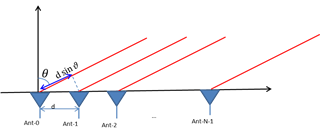Other Parts Discussed in Thread: DCA1000EVM,
Hi,
I am working with DCA1000EVM to capture raw ADC samples that I use for target detection indoors as well as angle of arrival estimation for each detected target.
I use Tx1 for transmission and Rx 1 and Rx 2 to estimate the angle for a target. In my scenario, a human subject is standing still at 2 meters in front of the radar sensor at 45 degrees from boresight (i.e. 0 degrees in front of the radar sensor). In other words, with respect to the radar's field of view, the subject is on the left side of the radar by 45 degrees. When I calculate AoA using 20 consecutive radar frames based on phase difference between the two antennas (i.e. Rx 1 phase - Rx 2 phase) using the 1D range profiles for each antenna, I get the following:
frame 0:: AoA = 128.61099399096278 deg
frame 1:: AoA = -234.58167243987873 deg
frame 2:: AoA = -231.42251791081694 deg
frame 3:: AoA = 129.7642527155712 deg
frame 4:: AoA = 128.65872157429322 deg
frame 5:: AoA = 122.8344204189319 deg
frame 6:: AoA = 128.42252945934953 deg
frame 7:: AoA = -231.69782963103492 deg
frame 8:: AoA = -234.3479557367357 deg
frame 9:: AoA = 131.33170725305612 deg
frame 10:AoA = 126.21353422163743 deg
frame 11:AoA = 126.89442028982506 deg
frame 12:: AoA = 128.4065022269535 deg
frame 13:: AoA = -232.83841782067532 deg
frame 14:: AoA = 130.3237345306915 deg
frame 15:: AoA = 127.63677218439997 deg
frame 16:: AoA = 129.26764066018382 deg
frame 17:: AoA = -225.7170966610868 deg
frame 18:: AoA = -228.76257978766097 deg
frame 19:: AoA = -215.0836610479754 deg
After analysing the above, I came to the conclusion that with respect to the radar facing forward, the 0 degrees is defined on the right side of the radar while 180 degrees is the left side of it. Since my subject is located at 45 degrees to the left side of the radar, I would expect the AoA readings to be 135 degrees. In the above list, the positive angles are actually not far off from what I would expect so they seem to be correct.
The negative angles also seem to make sense if I take their 360 complement. In other words, if I add 360 to each negative angle, they also provide comparable results to the positive angles I was expecting to receive. The variance of the AoA seems a bit higher than I would have liked but I suppose they are within a reasonable range (I would probably calculate their averages as the final AoA for this target based on the 20 frames above)
My question is whether the above interpretation of the AoA readings I am seeing makes sense. Is this the type of AoA readings you would expect to get when Rx 1 and 2 are used on IWR6843ISK? Does taking the 360 complement for the negative angles look valid? Is it normal to see negative and positive angles as above?
Thank you for your help.
Regards,
Cagri


